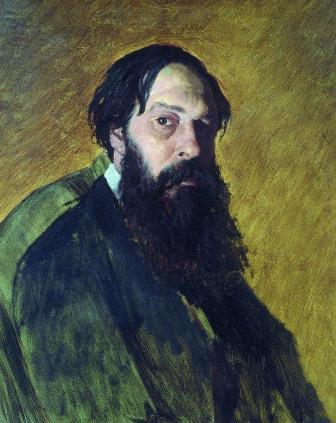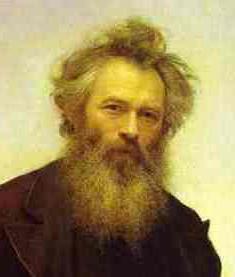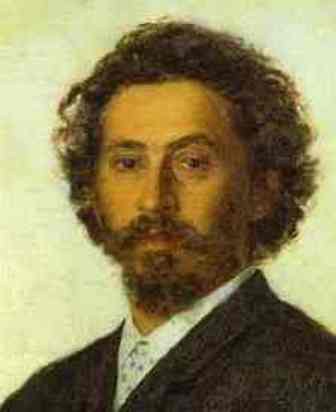The legacy that the Wanderers left behind is truly great and multifaceted. It was they who began to depict in their paintings ordinary people, their way of life, mores, feelings and emotional state. On the canvases of artists of the Wanderers, one can also see plots from Russian history that embody the unbending strength of the spirit of the common people. Among the masterpieces of this era there are also portraits of eminent people and nobles.
Partnership History
The Wanderers were the first Russian realists. They contrasted their work with strict academic canons, far from modern reality and the demands of modern life. Partnership of traveling exhibitions was organized in St. Petersburg. An interesting story is the creation of this community. In 1863, the fourteen best graduates of the Academy of Arts demanded permission from the leadership to freely choose the theme of the competition picture. Having been refused, young students, without hesitation, withdrew from the educational institution, organizing a free artel. In 1870, at the initiative of V. Perov, they, together with Moscow artists, created the Association of Traveling Exhibitions. The first exhibition was opened in 1871. In their works, young realists sought to depict the true life of the constantly suffering and oppressed peasantry, under the rule of the rich and landlords. The exhibitions organized by the Wanderers were a huge success, and among the most diverse segments of the population.
Over the entire existence of the association, forty-eight exhibitions were held in Moscow, St. Petersburg, Riga, Yaroslavl, Tula, Saratov, Chisinau, Kazan, Kursk, Voronezh, Poltava, Kharkov, Odessa, Kiev and other cities. “People's expositions” also began to be arranged in small cities, villages and villages. Enlightenment of the common people is one of the ideas pursued by the Wanderers. The list of participants in this community includes the best sculptors and painters of the nineteenth to twentieth centuries. Among them are quite famous G. G. Myasoedov, V. Petrov, I. Kramskoy, K. Savitsky, G. Savrasov, A. Kuindzhi, I. Shishkin, I. Repin, V. Vasnetsov, I. Levitan, S. Ivanov, A Arkhipov and other eminent figures.
Creative activity
November 29, 1871 in St. Petersburg, the opening of the first traveling exhibition. The exposition presented the works of sixteen painters. Forty-seven paintings were exhibited for the audience. Later, already in Moscow, the number of exhibited paintings reached 82. The same exposition was subsequently transported to Kiev and Kharkov. Such paintings by Russian artists of the Wanderers, such as May Night (I. Kramskoy), Hunters at Rest, Portrait of the Merchant I. S. Kamynin, Fisherman, Portrait of A. N. Ostrovsky (V. G . Perova), "The Rooks Have Arrived" (A. Savrasova), "The Empty" (I. Pryanishnikov) went down in the history of Russian art. In their works, realists relied not only on the experience of Russian painting, but also on the achievements of classical and contemporary world art. Many representatives of the partnership in different years in the direction of the Academy of Arts visited foreign countries, where they adopted the experience of their colleagues, studied painting of different eras and styles. They realized their observations and impressions of what they saw in the works. The art of the Wanderers largely determined the movement of world painting of the nineteenth and twentieth centuries.
Alexey Savrasov

Landscape painter. He is one of the founders of the Association of Wanderers. In 1844, against the will of his father, the young artist entered the school of painting, which he successfully completed in 1850. The first landscapes of Alexei Kondratievich - "View of the Kremlin in inclement weather", "View of Moscow from the Sparrow Hills" - imbued with the ideas of romanticism. Savrasov actively participates in exhibitions, teaches at the School of Sculpture and Painting. In 1862 he made a trip abroad, where he visited the London Art Exhibition, Paris, Munich, Dresden, Berlin, Copenhagen, etc. German and English painters especially attracted the attention of the artist with their desire for independence and truth. During this period, Alexei Kondratievich wrote one of his famous paintings - “Elk Island”, for which he was subsequently awarded a prize at a competition in Moscow. Since 1870, he and his wife have been traveling in Russia (Kostroma, Yaroslavl, Novgorod). He conveys his impressions of the beauty of his native nature in paintings. So there is a "Volga Spill" and "Rooks have arrived." It was these paintings that were presented at the first exhibition, organized by Russian Wanderers. In the works written in the 870s, anxiety and sadness are felt more and more: “Sunset over the swamp”, “Moonlit night”, “Graves over the Volga”, “Rye”. The artist spent the last years of his life in deep need.

Ivan Shishkin
The names of the Wanderers are known far beyond the borders of their homeland. A striking example of this is I. Shishkin. It is with his name that the history of the domestic landscape is associated, his creations became national classics and gained immense popularity. The future artist was born in the small town of Elabuga in the family of a merchant in 1832. In 1848, he entered the Kazan Gymnasium, but did not graduate from it. Having returned home, for a long time he is in search of his future path. At the age of twenty, the young Shishkin enters the school of painting, where he immerses himself in study and creativity. The artist is constantly painting. He is inspired by nature, forest and village landscapes, peasant life. The first work of Shishkin that has come down to our times is Pine on a Rock. The oil painting was painted in 1855. In 1856, Ivan Ivanovich entered the Academy of Arts (Petersburg). His early works are imbued with romance. In 1858, he painted one of his most famous paintings, "View on the Valaam Island." For this work in 1860 at the academic exhibition he was awarded a gold medal. After graduating from the Academy (1860), Shishkin goes abroad. During this period, he creates a little-known masterpiece "View in the vicinity of Dusseldorf", presented at an exhibition in Paris. Upon returning to his homeland, Ivan Ivanovich became close to I. Kramsky, the founder of the Artels' Artists. In subsequent years, he painted a number of landscapes ("In the vicinity of Moscow", "Logging", "Ship Grove", "Stream in the Forest"). He constantly exhibits his works at expositions arranged by Russian artists of the Wanderers. To this day, the masterpieces of this great landscape painter are very popular.

Ivan Nikolaevich Kramskoy
Russian wanderers of the 19th century created a huge portrait gallery. In their works they portrayed the best people of the country, prominent figures of science, culture. Many masterpieces were written by order of the famous philanthropist and collector P. Tretyakov. Truly brilliant portrait painter was I. Kramskoy. The strengths of the talent of this bright artist and psychologist were manifested in the portrait of Leo Tolstoy. This masterpiece was painted in 1873 in Yasnaya Polyana. The artist puts forward the clear and wise mind of the writer. The image of the famous Russian writer is based on contrast (internal significance and external simplicity). Another significant work of Kramskoy is the picture "inconsolable grief", which conveys the entire depth of maternal feelings. In the years 1860-1870, he actively participated in the organization of exhibitions held by Wanderers. At the second exposition, Kramskoy's work “Christ in the Desert” was presented. The artist’s legacy is mainly comprised of portraits of ordinary people: “Woodland”, “Unknown”, “Peasant with a Bridle”, etc.

Ilya Efimovich Repin
Perhaps the most significant phenomenon in the history of Russian painting was the painting "Barge Haulers". In his work, the artist colorful showed the image of ordinary people. Prior to Repin, no one turned to such a deeply tragic and amazing plot. In this masterpiece, the artist showed his mastery of all means of art to perfection. Another significant creation of Repin - "Religious procession in the Kursk province." Painted in 1883, the painting attracts with its unusual pictorial and compositional solution. The religious procession depicted in the picture personifies the collective image of the village with all its groups and classes. With special love and sympathy, the author was able to draw images of ordinary peasants. A special place in the work of the painter is a revolutionary theme. He created the paintings "Under escort", "Did not wait", "Refusal of confession." In the 1880s, Ilya Efimovich turned to the portrait genre, depicting prominent figures of our time, such as D. Mendeleev, A. Delvig, M. Glinka and others.
Vasily Maksimovich Maksimov
He received his first artistic skills in icon painting workshops. Vasily Maksimovich graduated from the St. Petersburg Art Academy with a degree in historical painting. The artist devoted all his work to the image of an original peasant world. His paintings are not striking in the sharpness of the plots and bright colors. However, this feature only attracted the attention of art lovers. His most famous works are: “Everything is in the past”, “Sick husband”, “Family section”. Like many other wanderers of the 19th century, Vasily Maximovich in his work sought to reflect the creative ideals and values of his time.
Vasily G. Perov
Born in Tobolsk in 1834. At a young age, a young artist enters the School of Painting. His first significant work is “Arrival of the Investigative”. Masterpieces written in his youth were a huge success at traveling exhibitions. Soon, for the painting "A Sermon in the Village" Vasily Grigoryevich was awarded a gold medal. His first paintings reflect the author's socio-critical orientation. A vivid example of this is “Rural Religious Procession for Easter”, “Sermon in the Village”, etc. In later years, Perov acts as a portrait painter and landscape painter. He owns portraits of F. Dostoevsky and A. Ostrovsky. It was Vasily Grigorievich who was one of the initiators of the Partnership’s active actions.
Abram Efimovich Arkhipov
This artist has an important place in the genre painting of that time. In his masterpieces, Arkhipov most faithfully portrayed the life of a simple rural people. His paintings “Reverse”, “On the Oka”, have received wide recognition throughout the world. In some of his works, he reveals social problems (“Laundresses”, “Day laborers”, etc.), depicting hard peasant labor.